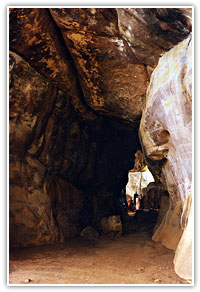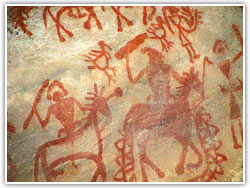|
|
Bhimbetka, Madhya Pradesh
.............................................................................................................................................................................. |
|
Information about Bhimbetka
Surrounded by the northern fringe of the Vindhyan
ranges, Bhimbetka lies 46 km south of Bhopal. In
this rocky terrain of dense forest and craggy
cliffs, over 600 rock shelters belonging to the
Neolithic age were recently discovered. Here, in
vivid panoramic detail, paintings in over 500
caves depict the life of the pre-historic
cave-dwellers making the Bhimbetka group an
archaeological treasure, an invaluable chronicle
in the history of man. Executed mainly in red and
white with the occasional use of green and yellow,
with themes taken from everyday events of eons
ago, the scenes usually depict hunting, dancing,
music, horse and elephant riders, animals
fighting, honey collection, decoration of bodies,
disguises, masking and household scenes. The
superimposition of paintings shows that the same
canvas was used by different people at different
times. The drawings and paintings can be
classified under seven different periods. Animals
|
 |
|
|
such as
bisons, tigers, lions, wild boar, elephants, antelopes,
dogs, lizards, crocodiles, etc. have been depicted in
some caves. Popular religious and ritual symbols also
occur frequently. The colours used by the cave dwellers
were prepared combining manganese, hematite, soft red
stone and wooden coal. Sometimes the fat of animals and
extracts of leaves were also used in the mixture. The
colours have remained intact for many centuries due to
the chemical reaction resulting from the oxide present
on the surface of the rocks. The best season to visit
this place is from July to March.
Tourist
Attractions in Bhimbetka
Period I - (Upper Paleolithic)
These are linear representations, in green and dark red,
of huge figures of animals such as bisons, tigers and
rhinoceros.
Period II - (Mesolithic)
Comparatively small in size, the stylized figures show
linear decoration of the body. In addition to animals,
there are human figures and hunting scenes, giving a
clear picture of the weapons they used - barbed spears,
pointed sticks, bow and arrows. The depiction of
communal dances, birds, musical instruments, mother and
child, pregnant women, men carrying dead animals,
drinking and burials appear in rhythmic movement.
Period III - (Chaleolithic)
Similar to the paintings of Chaleolithic pottery, these
drawings reveal that during the period, the cave
dwellers of this area had come in contact with the
agricultural communities of the Malwa plains and started
an exchange of their requirements with each other.
|
| |
|
Period IV & V - (Early History)
The figures of this group have a schematic and
decorative style, and are painted mainly in red,
white and yellow. The association is of riders,
depiction of religious symbols, tunic-like dresses
and the existence of scripts of different periods.
The religious beliefs are represented by figures
of yakshas, tree gods and magical sky chariots.
Period VI & VII - (Medieval)
These paintings are geometric, linear and
|
 |
|
|
more schematic, but show
degeneration and crudeness in their artistic style.
|
|
|
|
How to
reach Bhimbetka
By Air
Bhopal (46 km from Bhimbetka) is the nearest airport.
It is connected with Mumbai, Delhi, Jabalpur, Indore and
Gwalior.
By Rail
Bhopal, on the Delhi-Chennai and Delhi-Mumbai mainline
is the most convenient rail-head.
By Road
Bhimbetka is connected by bus with Bhopal. |
|